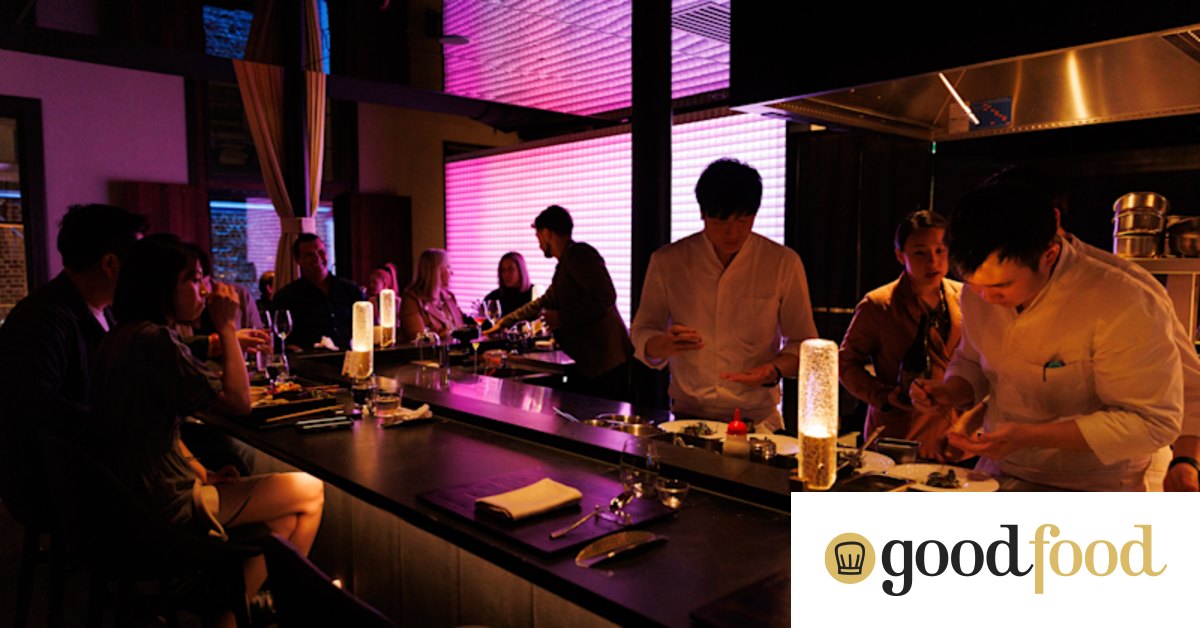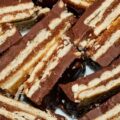With a luxury dining room that seems to be direct from Bladerunner, the kitchen needs Garaku increases to find its location.

Japanese$$$$
THE Good food guide There is no bathroom prize of the year, but if they did, there would be some candidates. The tents painted with flowers, rainbows and Timothy Vernon Moore farm animals on the corner 75. The loose marble floors flanked by red-tiled tiles on the grill. And now Garaku’s, the walls wrapped with embroidered by the urban landscapes of Japan, dotted with anime and yokai characters and lit by the bridge.
Bathrooms are not or break for a restaurant, but they can dive a little more deeply. In Garaku, the most prize of six places placed on three levels that make up the City Hall 48 (Japan has 47 municipalities; “P48” plays being one more), the bathrooms say this is a place that cares about details, about art, but still knows how to have fun.

As guiding principles, these are quite promising. But don’t go to Garaku for the bathrooms. Go because it is one of Sydney’s most impressive openings of the last 12 months, adjusted for some tables per night and a handful of ringworm guests who have tickets for a menu accurately executed by chef Derek Kim.
Fluttery Sheets of Tofu skin, for example, floating in a crystal bowl similar to a lotus flower and hiding the chosen king crab in hot dashi: a restriction world, a texture exploration. The raw fish course brings together the deep red-tailed red and salt-roasted beef, lift them with lap and lemon and the top with nasurtium leaves, such as fresh spring spring sprouts.

Garaku is part of the Azabu group, which also manages the very good Choji Yakinuku and Shabu Shabu expert Hanasuki, in Chatswood, and sent an overproduced press release when the restaurant was opened last October: “It’s cooking as a performance.” Garaku was named Gagaku, by the way, the music of the imperial court played during the Heian period of Japan.
The TLDR is that Garaku specializes in Kaiseki dinner, a seasonal procession of dishes whose tips in the last 15 years have infiltrated almost every major kitchens. The beats are familiar, but fortunately this is not the theater at Alinea level in Chicago, with its floating apple -flavored helium balloons.
Yes, a program that accompanies the menu presents as a Playbill, but instead of being an exaggeration, it is really a little cute. If you would like to know that the crab course is based on Kyoto’s temple cuisine, that tuna and beets plate represents the dirt and sea meeting in Wakayama, or what is the Sous-Chef Sean favorite service moment is (spoiler alert: it’s watching your first bite), it’s all there.

If Garaku is sincere on paper, on the plate is detailed, accurate. The emperor, a fish often served raw, is grilled over embers, cut and rose with the Dashi of Sorrel, dotted with salmon robot. Takeda Ten Wagyu Rib El is bright and butored pink, served with slowly cooked mushrooms in algae oil and a clear nest made of Sassify.
Kim cooked at Tetsuya’s for nine years, serving as executive chef before closing, which if nothing more means that his knife skills would mark close to 10 on Instagram account, evaluates my chives. But his food has the same equilibrium and balance quality as Tetsuya’s, and the fact that many chefs followed him from the restaurant means things flow smoothly.
TETS never had a snack like Kim’s, but a winter Zen garden decorated with fall leaves and sprouting flowers. Of the four bites are the folds of Ponzu jam and a japanese pumpkin pie covered with zucchini with tiles cut into a perfect circle (apparently Sean’s enemy) who speak more clearly.

This is upside down, cooking with tweezers, but if you have a chance to add the $ 25 course in Shokuji after the power grid (and an impressive Koji-Polhied Marron), it runs in another direction, with Kim lifting Lid in a clay, a rich and aromatic rice with lordin lords, and clay and argillas, with a tunic, with a tunic of a tunic Barrante, with grade, with lido, the tunic of clay and clay and clay and clay and clay and clay and clay articulated with lid lido, worried about leaving a tasting feeling dissatisfied? Kim sees you. Meanwhile, the desserts are clean and fresh, if a little safe.
This is not performative art, but there is theater in it. A dark quartzite counter in front of a flawless kitchen is the stage, lit by a work of art from the pixel panel that unloaded blue and pink and gold by the space designer Hiroto Yoshizoe.
For drinks, the depth of the crystal bowl is mirrored in a glass of low -cut Martini, passing around a radius of Roku Gin, sachet and Lillet Blanc, ended their choice of Japanese bitters (try umami or cherry).
Sommelier Tanya Nhuen mixes this cocktail and is so skilled at recommending Junmai Sake, South -African Chenin and Mac Forbes Chardonnay. Its pairs, which may include hot and cold wines from the island of the island, also seem an exciting ride. Looking forward to seeing the bathroom? Drink deeply.
The low down
Atmosphere: Spotlit Black Sanctuary and Chrome Lited by BLADERUNNER-Sque Neon
Search dishes: Yuba Sakizuke, King Crab, Fioretto and Tsuyu Dashi; Japanese pumpkin, salmon and zucchini pie; Clay rice with ikura, crispy mushrooms, ebi and octopus
Drinks: Chablis, Burgundy and Rare Sake, supported by many cunning and priced local drops.
Cost: $ 229 for seven courses, or $ 330 for 10 courses, per person
Good food reviews are reserved anonymously and paid independently. A restaurant cannot pay for a review or inclusion in the Good food guide.
Restaurants of restaurants, news and warmer openings served to your inbox.
Register
Of our partners


